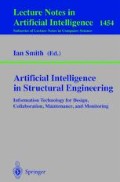Abstract
Today most of the information we produce is stored digitally. We are slowly forced to leave behind us thinking about information as something stored in physical containers as books, drawings etc. We make it possible to dynamically create logical containers of information on the fly. The paper focuses on how we in the future can aggregate, classify and generalize digitally stored information in order to make it more accessible and how we can define underlying knowledge container models to support knowledge discovery and collaboration. Examples are picked from ongoing research and the outcomes are generally valid and in particular for the structural engineering field.
Preview
Unable to display preview. Download preview PDF.
References
Bryan, M.,: Guidelines for Using XML for Electronic Data Interchange. Version 0.05, 25th January (1998). XML/EDI Group. http://www.geocities.com/WallStreet/Floor/5815/guide.htm
Christiansson, P.: Experiences from developing a Building Maintenance Knowledge Node. In CIB Proceedings Information Technology Support for Construction Process ReEngineering, IT-CPR-97. (1997) 89–101. (http://delphi.kstr.Ith. se/reports/cibw78caims l 997.html).
Christiansson, P.: Knowledge communication in the building industry. The Knowledge Node Concept. In Construction on the Information Highway. CIB Proceedings 198 (ed. Z. Turk) (1996) 121–132. (http://delphi.kstr.lth.se/reports/cibw78bled96.html)
Christiansson, P.: Dynamic Knowledge Nets in a changing building process. Automation in Construction, Vol 2, nb 2, Elsevier Science Publishers B.V. Amsterdam, (1993) 307–322
Conceptual Knowledge Markup Language, CKML. (Robert Kent, Washington State University, Christian Neuss, Technishe Hochschule Darmstadt) http://wave.eecs.wsu.edu/WAVE/Ontologies/CKML/RDF-to-CKML.html
Daniel Jr., R., Ianella R., Miller E.: Expressing the Dublin Core in the Resource Description Framework: Suggestions based on an early examination of the problem. Los Alamos National Laboratory. (7 A4 pages). (1997) http://www.acl.lanl.gov/-rdaniel/RDF/DC/ExpDC-2.html.
Freeman, J.A., Skapura, D., M.: Neural Networks. Algorithms, Applications, and Programming Techniques. Addison-Wesley Publishing Company. Reading Massachusetts. (1991) 17–18
Lagerstedt, R., Christiansson, P., Engborg U.: User Models in Search and Navigation Systems on the Internet”. Proceedings of the Third Congress held in conjunction with A/E/C Systems'96. ASCE Technical Councils on Computer Practices. (1996) 21–27 (http://delphi.kstr.ith.se/reports/aec96.htmi)
Honkela, T., Kaski, S., Lagus, K., Kohonen, T.: Self-Organizing Maps of Document Collections. Neural Networks Research Centre, Helsinki University of Technology. (5 A4 pages) (1997). http://www.diemme.it/-luigi/websom.htmi
Mace, S., Flohr, U., Dobson, R., Graham, T.: Weving a Better Web. BYTE, March (1998) 58–68.
Metadata Tools and Services. Distributed Systems Technology Center. University of Queensland Australia. http://metadata.net/dstc/.
Modin, J.: KBS-Class: A neural network tool for automatic content recognition of building texts. Construction Management and Economics. Special issue on Information Technology in Construction. (1995) 411–416
Resource Description Framework (RDF) Model and Syntax W3C Working Draft 16 Feb 1998. http://www.w3.org/TRJWD-rdf-syntax/
Author information
Authors and Affiliations
Editor information
Rights and permissions
Copyright information
© 1998 Springer-Verlag Berlin Heidelberg
About this chapter
Cite this chapter
Christiansson, P. (1998). Using knowledge nodes for knowledge discovery and collaboration. In: Smith, I. (eds) Artificial Intelligence in Structural Engineering. Lecture Notes in Computer Science, vol 1454. Springer, Berlin, Heidelberg. https://doi.org/10.1007/BFb0030442
Download citation
DOI: https://doi.org/10.1007/BFb0030442
Published:
Publisher Name: Springer, Berlin, Heidelberg
Print ISBN: 978-3-540-64806-2
Online ISBN: 978-3-540-68593-7
eBook Packages: Springer Book Archive

